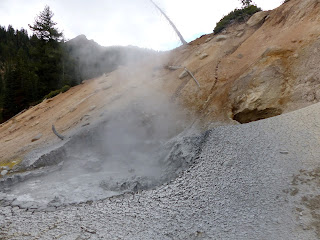 |
| Lower Twin Lake |
I’d seen an article in
Sunset magazine about a trip down US395 to see fall colors. Sounded like a plan, although I hadn’t
realized that the season for the area was over by the end of October, even if the colors weren't showing yet. We stayed at a campground near Twin Lakes
outside Bridgeport, CA. We had it almost
to ourselves.
George hadn’t been feeling well since Lake Tahoe,
and ended up going to a clinic in Bridgeport. He got a prescription, but the closest drug store was in Mammoth Lakes 50 miles south. The medicine made him sicker, but the next day was Saturday and the local clinic was
closed, so we had to go to the hospital in Mammoth Lakes. Turns out his body wasn't happy at 7,000', at least for more than just passing through.
Mono Basin National
Forest Scenic Area was on my itinerary, but I hadn’t planned on a travel
partner who was having problems with the elevation. We stopped at the Mono Lake Overlook. I’d never seen a guard rail completely covered with
bumper stickers. I would have said it would be tacky, but it's more fun and doesn't hurt anything. Start reading the stickers and you'll find a few slogans you agree with, many you don't, and a whole lot more local ones you don't even understand! View of Mono Lake is pretty good too.
The basin is impressive, containing a saline soda lake with no outlet. Water from the river running into it is diverted to Los Angeles, and a lot of the bumper stickers are commentary about that. Not being from California, those were some of the ones I didn't understand.
On the way back from Mammoth, we stopped at the Mono Basin Visitor Center.
We went out back but didn’t go down to the lakeshore. George is a wimpier patient than I am! I really wanted to see the tufa towers, calcium-carbonate spires and knobs formed by interaction of freshwater springs and alkaline lake water. Good thing I’ve got a telephoto lens.
Shades of blue everywhere.
The basin is impressive, containing a saline soda lake with no outlet. Water from the river running into it is diverted to Los Angeles, and a lot of the bumper stickers are commentary about that. Not being from California, those were some of the ones I didn't understand.
On the way back from Mammoth, we stopped at the Mono Basin Visitor Center.
Shades of blue everywhere.
































































